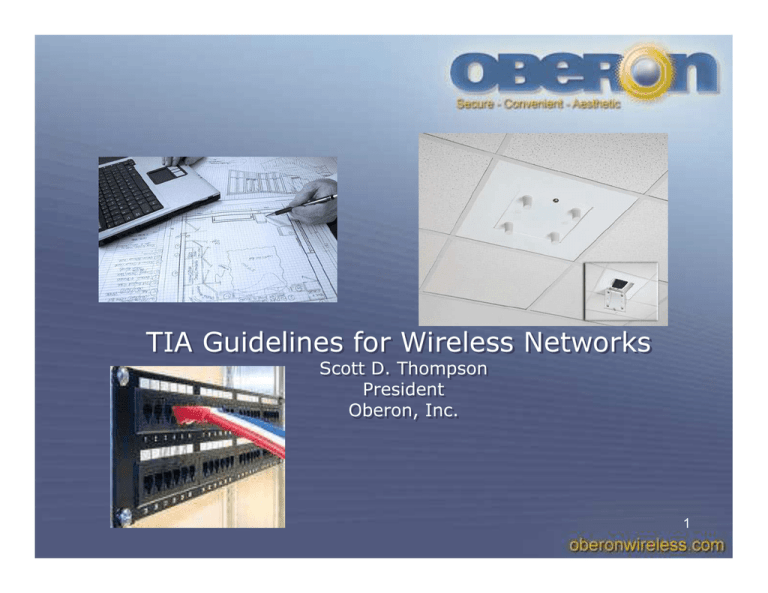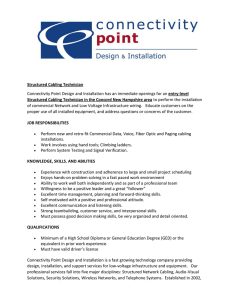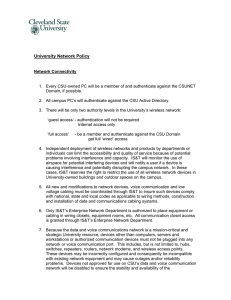TIA Guidelines for Wireless Networks
advertisement

TIA Guidelines for Wireless Networks Scott Scott D. D. Thompson Thompson President President Oberon, Oberon, Inc. Inc. 1 We manufacture ceiling and wall mounted Telecommunications Enclosures (TEs) for wireless LAN access points and other networking components Wireless AP enclosure Workspace TE 2 TIA standards often thought of regarding “cabling” TIA TR-42 is Telecommunications Cabling Systems, but the wireless design is impacted by cabling standards, pathways and spaces, powering, and access point locations. IEEE 802.11 wireless LAN access Points (which may also be Wi-Fi certified for interoperability), will work over a TIA compliant cabling 3 TIA 568-C Standards for Structured Cabling 568-C.0 Generic Telecommunications cabling for Customer Premises 568-C.1 Commercial Building Telecommunications cabling standard 568-C.2 Balanced Twisted Pair Telecommunications Cabling and Components Standards 568-C.3 Optical Fiber Cabling Components Standard 568-C.4 Coaxial Cabling (IN DEVELOPMENT) 4 Other Standards for Structured Cabling TSB-162 Telecommunications Cabling guidelines for wireless access points TIA 569-B Commercial Building Standard for Telecommunications Pathways and Spaces TSB-184 Guidelines for supporting Power Delivery over Balanced Twisted Pair Cabling TIA-862-A Building Automation Systems Cabling Standard for Commercial Buildings Draft TIA-1179 Healthcare Facility Cabling 5 TSB-162 –Guidelines for Wireless Telecommunications Systems Bulletin TSB162 Telecommunications Cabling Guidelines for Wireless Access Points (APs) Provides guidelines on the topology, design, installation, and testing of cabling infrastructure for supporting wireless local area networks (WLANs) 6 TSB-162 Guidelines for Wireless TSB-162 states that cabling should be installed and performance tested per existing 568-B.2 standards. Determination of exact cell size and placement of the AP is outside the scope of the TSB (perform a site survey or simulation) 7 TSB-162 Cabling Guidelines for Wireless Access Points 5,650 sq.ft. circular cell Lmax=13 m (42 ft) AP Hmax=81 m (265 ft) TR TO TO r=13m (42 ft) Patch=6m (20 ft) EQUIPMENT (switch) TO TO X=18.3 m (60 ft) Equipment in the Telecom Room TO Meeting room 3,600 sq.ft. square cell 8 TSB-162 Cabling Guidelines for Wireless Access Points 9 TSB-162 Cabling Guidelines for Wireless Access Points • Recommends an in-the-grid ceiling mount, with antenna un-obstructed by ceiling tiles • Recommends wall mount above or below suspended ceiling. AC power must be in an approved enclosure above the ceiling • Telecommunications Enclosures (TEs) can be mounted in a ceiling panel to provide locked security or aesthetics for APs • Consider maintenance and security of APs • Observe separation of power and network cabling • Local power or PoE acceptable (end span or mid span) 10 TIA 569-B “Pathways and Spaces” TIA 569-B Commercial Building Standard for Telecommunications Pathways and Spaces • Suspended ceiling space is acceptable for consolidation points and horizontal connection points, provided that the space is accessible without moving building fixtures and heavy furniture. • Inaccessible ceiling areas shall not be used as a distribution pathway • A minimum of 3” clear vertical space shall be available above ceiling tiles for horizontal cabling 11 TIA 569-B “Pathways and Spaces” Per TIA 569-B: • The TE may serve an area up to 3,600 sq. ft. and may replace a TR in office spaces less than 5,000 sq. ft. • The TE shall be placed as close as practicable to the center of the area served • The TE shall facilitate access for maintenance and MACs, and control unauthorized access. • The TE shall provide lighting for maintenance and adequate power and ventilation for equipment contained therein. • A Telecommunications Enclosure (TE) may augment a Telecommunications Room (TR) on each floor of a building 12 TIA 569-B “Pathways and Spaces” Telecom enclosure in the ceiling Support wires to structure TO or TR Data Cables Air-Handling Space Air-Duct “Plenum Space” 3” E-net Switch Patch Panel Wireless AP Telecommunications or access point enclosure Locking access panel or door (must be accessible) Line Power Ceiling Tiles Workspace (up to 3600 sq ft) Antennas 13 Power Over Ethernet (PoE and PoE+) TIA TSB-184 : Guidelines for Supporting Power Delivery Over Balanced Twisted-Pair Cabling • Recommends CAT5e, or better, horizontal cabling • DC Loop resistance and balance • End-span and Mid-span configurations • Tables of temperature rise within cable bundles • References to safety standards • The TIA has conducted tests with the higher current levels in cable bundles verifying that PoE plus cabled infrastructure can be operated safely in the air handling space. 14 Power Over Ethernet (PoE and PoE+) IEEE 802.3af (PoE) and 802.3at (PoE+) DTE Power via Media Dependent Interface (MDI) • PoE delivers 12.9W to PD delivered over DATA or SPARE pairs • PoE + delivers 24W to PD • PoE + delivers over 2 or 4 pairs. Some solutions may deliver 60Ws to PD • Interoperable, interchangeable with existing PoE infrastructure 15 INSTALLING THE AIR HANDLING SPACE Ideal location for networking gear is in the ceiling, but…… What does the National Electric Code (NEC) say about the air handling space (sometimes called “plenum”) above a suspended ceiling? - NEC article 300.22(c) FPN “The space over a hung ceiling used for environmental air-handling purposes is an example of the type of other space to which this section applies”. 16 N.E.C. COMPLIANCE NEC article 300.22(C)(2) “Electrical equipment with a metal enclosure, (or otherwise listed) shall be permitted to be installed in this other space (airhandling space) unless prohibited elsewhere in this Code”. NEC article 300.23 “cables, raceways and equipment installed behind panels, including suspended ceiling tiles, shall be arranged and secured so as to allow removal of panels and access to the equipment.” 17 What is “Plenum Rated” • Equipment is sometimes said to be “Plenum rated” if it is UL2043 listed • UL2043 “is a fire test method for determining the fire performance response of discrete products (including, but not limited to electrical equipment) intended to be installed in air handling spaces, such as above suspended ceilings or below floors……” • Equipment not UL2043 listed should be in a metal enclosure (per NEC article 300.22(C)(2) ). 18 Presentation available at http://www.oberonwireless.com/webinars.php Please view product demonstrations at http://www.youtube.com/oberoninc 19




